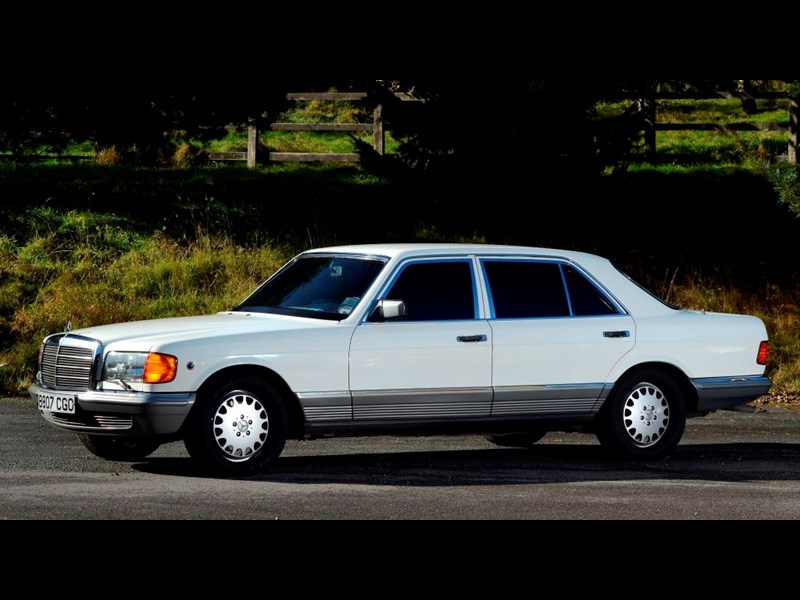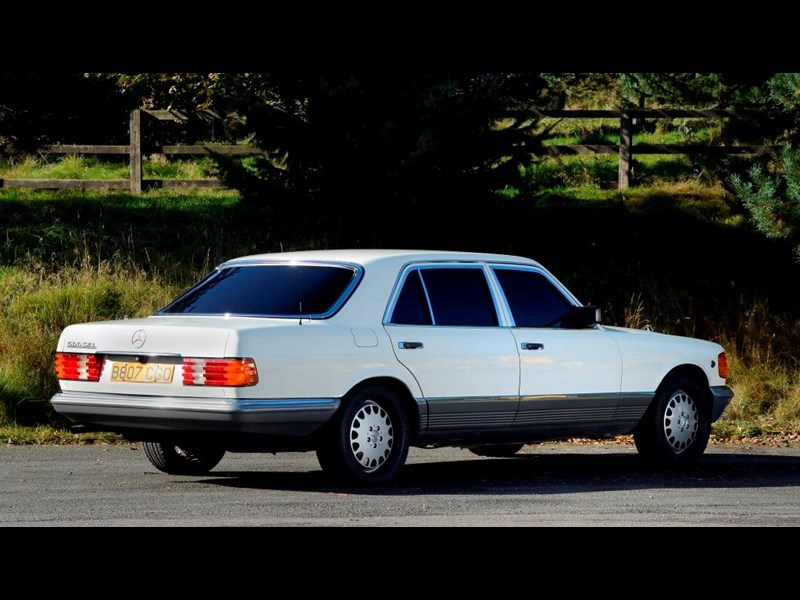This year marks half a century since the original Mercedes S-Class was launched. The third-generation car is now a bona fide classic – and it’s still impressive enough to trounce many moderns.
For most of the time since it was introduced in 1965, the Mercedes S-Class has represented the pinnacle of automotive prowess. This flagship of the Mercedes range has usually been the model that gets the cutting-edge tech first, offers the greatest refinement and always features ample performance. The S-Class often features technology that won’t feature in mainstream cars for years or even decades.
When the W126 S-Class made its debut in 1979 (1980 in the UK), buyers could choose from a 280SE, 380SE/SEL (the latter getting a 4.5-inch longer wheelbase) or a 500SE/SEL. A facelift in autumn 1985 brought fresh bumpers and valances along with 15-inch wheels in place of the previous 14-inch items. More significant was the new 3.0-litre 300SE in place of the previous 280SE, while a 4.2-litre V8 superseded the 3.8 unit. The 500SE and SEL remained as before, but from autumn 1986 came a new flagship – the 560SEL with a 295bhp 5.6-litre V8. A year later the 5.0-litre engine was tweaked to give 262bhp instead of the previous 240bhp. By this point anti-lock brakes were standard range-wide; they’d previously been optional on the cheaper models.
Unsurprisingly, most of the really good S-Classes that remain have one of the bigger V8s and are loaded with equipment from anti-lock brakes to airbags, which makes the S-Class one of the strongest and safest classics around, despite its advancing years. As result it’s amazingly luxurious and comfortable, so it’s perfectly suited to long-distance cruising; any S-Class – including the six-cylinder editions – easily capable of swallowing four people and their luggage for even the most demanding of journeys.
However, despite its size and complexity, an S-Class needn’t cost a fortune to run, thanks to fuel-efficient engines and a lot of maintenance can be done on a DIY basis. Some parts prices are steep though, with no cheaper alternatives available. As a result, if you buy a good one and look after it you can spend surprisingly little cash on keeping an S-Class in rude health, but buy badly and you’ll need very deep pockets indeed to keep the thing going.
VITAL STATISTICS
1985 500 SEL
Engine 4973cc/8-cyl/OHC
Power (bhp@rpm) 231@4750
Torque (lb ft@rpm) 298@3200
Top speed 131mph
0-60mph 8.0sec
Consumption 17mpg
Gearbox 4-speed auto
WHAT TO LOOK FOR
- The S-Class can rot badly, although only neglected cars should be showing significant corrosion. The wheelarches, sills and valances need close inspection, as do the lower portions of the leading edge of the front wings, just above the bumper. If the rear parcel shelf has rotted, the car’s structure has been compromised; repairs could easily run to £3000, especially if the rear wings have rusted too.
- All these S-Classes have a straight-six or V8, from 2746cc in the 280 to 5547cc in the 560. As long as the oil and filter have been changed every 6000 miles, the engines will notch up 150,000 miles between top-end overhauls – the bottom end lasts forever if maintained. The M116/117 all-alloy V8 is light and strong, but anti-freeze levels must be maintained to avoid internal corrosion. On the V8, rattling or clattering on start up, which dies as the engine warms, points to worn duplex timing chains and tensioners; a specialist charges around £750 to fix it. A constant clattering – or ticking – suggests a worn camshaft or cam follower. Especially likely on the bigger engines, DIY repairs are feasible. The parts cost around £2000; a specialist will take 8-9 hours to fit them. The oil pressure needle should be at the top of the dial (3) when cold, dropping to 1 or 2 when warm and idling. Much lower and a bottom-end rebuild is due.
- Six-pot cars got a manual gearbox or optional auto; the former are rare. All V8s have a four-speed automatic gearbox, which lasts forever if the transmission fluid and filter are renewed every 36,000 miles or three years. The fluid should be red as only Dexron can be used – the dipstick is on the offside rear of the engine bay. Make sure the ratios are selected cleanly and that there’s no slipping under load; if there is, the box will need to be rebuilt at £800-1200. Decent used gearboxes are around £400.
- The solid rubber coupling on each end of the propshaft perishes, leading to clonks (and maybe vibrations) as the drive is taken up. Replacement couplings are £120 apiece. The same symptoms can come from worn universal joints on the propshaft or driveshafts. You can’t replace just the U/J on the driveshafts – you have to replace the whole thing at £300+ for the parts or £500 if a specialist does it for you.
- Power steering was standard, with leaks common, so look for signs of fluid escaping. Track rod ends wear and you should renew the whole track rod (at £55 each); you’ll need a four-wheel alignment check afterwards. Where fitted, the self-levelling rear suspension pipes can corrode and leak; a specialist will charge around £500 to make a new set from copper, and fit them. Put some weight in the boot and see if the ride height remains static; also try the car on bumpy roads and see if the ride is hard. If it is, the hydraulic spheres need replacing at £120 each – there’s one for each rear wheel.
- Most S-Classes came packed with equipment, so check everything. Focus on the fuseboxes on the offside bulkhead – check for dodgy contacts because of corroded terminals. While the switchgear is generally long-lived, the electric window switches, motors and regulators can fail. Also make sure the central locking works, as the system uses vacuum pipes, which leak – there are also valves which can stick. You’ll need pressure testing equipment to effect repairs. The vacuum pump itself could be damaged, with new ones £195.
- Many S-Classes feature leather trim, but others got cloth. While the latter is durable and comfortable, the car needs to be priced to sell; there are plenty of hide-trimmed S-Classes out there. If the interior has been allowed to get damp, the cost to fix everything won’t add up. There isn’t much exterior trim, but what’s there is costly to replace. Most of it is durable, but the chromed bumper inserts can rust through; new sets are £1000 apiece, although specialists and eBay can undercut this.
OUR VERDICT
It was the best car in the world when it was new, and the S-Class is still impressive. But neglected cars can be hugely costly to fix, and those used sparingly are often unreliable, so buy carefully. You’ll also need a big garage to house an S-Class, especially in SEL form.


